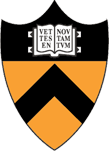| School | Troops | Resources |
Economics at Princeton

[Note: Part of the HET Website. This page is not related to or endorsed by Princeton University or any other organization. See the official Princeton University website.]
Princeton University in Princeton, New Jersey, is one of the Úlite "Ivy League" colleges of the United States. It was originally set up in 1746 as a Presbyterian seminary, known as the "College of New Jersey", its official name until 1896.
Princeton claims itself the successor of the "Log College", a Presbyterian seminary set up in 1726 by William Tennent in Bucks County, Pennsylvania, around the time of the "Great Awakening", a period of religious revival in the American colonies. The Log College sought to train Awakening-style preachers and ministers, as a revivalist antidote to the more conventional ministers coming out of the established colleges of Harvard and Yale. Controversy over the Log College led to a schism within the American Presbyterian Church in 1741, between "Old Side" and "New Side"churches. After Tennant's death in 1746, the Log College was closed, and the New Side Synod sought a replacement. A school was erected under pastor James Dickinson in Elizabethtown, NJ, and given a charter as the "College of New Jersey" in October 1746 by the New Jersey colonial governor. This is formally counted as the university's founding date. However, Dickinson died that same month, and the students moved to Newark in 1747, placing themselves under the tutelage of Aaron Burr, a Newark pastor. A board was organized at a meeting in New Brunswick a year later, and a fresh charter granted by governor Belcher in November 1748. The Synod launched a concerted campaign to collect donations from congregations around America to support the college. New Sider activists Gilbert Tennent and Samuel Davies were sent in 1752 to raise funds in Europe (England, Scotland, Ireland, etc.). Finally, in 1753, the college received a donation of land from Nathaniel FitzRandolph in the small town of Princeton (est. 1696), and the erection of buildings on the site began shortly after. Its first permanent building, Nassau Hall, was finished in 1756, and the college transferred from Newark to Princeton in 1756. However, Burr died in late 1757, and after some difficulties finding a new president (Great Awakening preacher Jonathan Edwards served for three months before his death), the College appointed Samuel Davies in 1759. But the College's bad luck with short-lived presidents continued (Davis died in 1761).
Things only finally settled in 1768, with the appointment of Scottish cleric John Witherspoon to assume the presidency of the College. Witherspoon had been trained at the University of Edinburgh, and was a prominent figure in the established Presbyterian Kirk of Scotland. But Witherspoon found the environment in Scotland, then under the growing liberal winds of the Scottish Enlightenment, increasingly to his distaste. Witherspoon was a leader of the older "popular faction" of fire-and-brimstone Calvinism in the Scottish Kirk against the liberalizing reforms pushed by the more elitist "moderate faction" (pushed by Hutcheson and his Glasgow students, like Adam Smith). Feeling he was losing ground, Witherspoon decamped for America to take up the presidency of Princeton. Despite his opposition to the Scottish Enlightenment writers, Witherspoon nonetheless re-cast Princeton in the Scottish mould, modeling the university's structure and curriculum after that of Edinburgh, and presided over a period of flowering for the next few decades.
Graduate School established in 1900. It was only in 1969 that Princeton admitted women into its undergraduate program.
(to be completed)
| The
|
HET
|
|
Resources on Princeton Economics
|
All rights reserved, Gonšalo L. Fonseca
